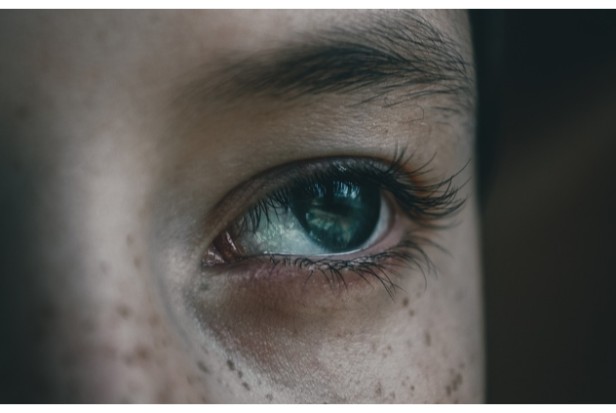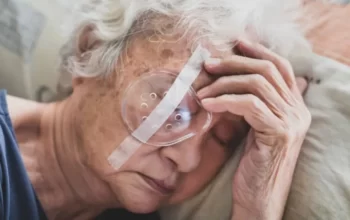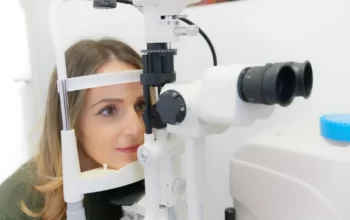
The optic nerve, which serves as the primary means of communication between the eye and the brain, is harmed by the eye condition glaucoma. It is brought on by an excess of aqueous humor, a type of fluid, in the front of the eye, which raises intraocular pressure.
According to the drainage angle, aqueous humor should enter the eye at the same rate that it leaves the eye. If the drainage angle isn’t working properly, fluid accumulates, eye pressure increases, and the optic nerve is harmed, eventually resulting in vision loss or impairment.
In actuality, glaucoma is the main reason for vision loss or blindness in people over 60. Glaucoma cannot be cured but can be treated if caught early enough. It is crucial that everyone is aware of the early glaucoma symptoms and warning signs.
What Is The Glaucoma’s Initial Symptom?
A group of diseases known as glaucoma affect the eye’s optic nerve and can cause permanent vision loss as a result of an increase in intraocular pressure. A major factor in vision loss and blindness is glaucoma. In order to diagnose and treat glaucoma before it causes serious vision loss, it is crucial to be aware of its early symptoms. Annual eye exams are advised by our Tucson doctors to check for glaucoma and other diseases that could affect vision.
In the US, glaucoma affects millions of people., but many of those are unaware they have the disease. Glaucoma cannot be cured at this time, but if it is caught early enough, there are treatments available. The warning signs of glaucoma vary depending on the type, and occasionally there are none at all, especially in open-angle glaucoma, which is the most prevalent form of the condition.
However, if you experience any of the following symptoms, you should seek immediate help:
Loss of peripheral or side vision: Usually, this is glaucoma’s initial warning sign.
Seeing halos around lights: Glaucoma may be present if you experience unusual light sensitivity or notice rainbow-colored circles around lights.
Vision loss: even more so if it occurs unexpectedly.
Redness in the eye: accompanied by pain from time to time, which could indicate an injury, an infection, or acute glaucoma.
The eye that looks hazy: The most typical early glaucoma sign in children is a cornea that appears cloudy.
Nausea or vomiting: especially if it is accompanied by excruciating eye pain.
Pain in the eye and in the head: This is a common occurrence in angle-closure glaucoma, a kind of disease that can advance quickly.
Tunnel vision: Around the edges of your visual field, you could begin to lose vision.
Even though the majority of glaucoma types cannot be prevented, early detection and ongoing eye health monitoring can reduce the amount of vision loss brought on by the condition. Make an appointment with Eye Associates of Tucson if you think you might have glaucoma or if you need to have your eyes checked.
Other Symptoms & Early Warning Signs Of Glaucoma
To summarize what we’ve learned so far, vision loss is typically the first glaucoma warning sign, though an eye exam might find it even earlier. The ideal situation is for the eye doctor to identify glaucoma before the patient experiences any vision loss or impairment.
That should answer the main question here, “What manifests as glaucoma’s initial symptoms?”
Having said that, patients should be aware of additional glaucoma early warning signs. The majority of these symptoms are glaucoma-specific. Open-angle glaucoma and acute angle-closure glaucoma are the two most prevalent varieties of the disease.
Some of the early signs of open-angle glaucoma include:
- Blind spots in your peripheral or central vision
- Tunnel vision (generally in advanced stages)
Some of the early signs of angle-closure glaucoma include:
- Severe headaches
- Nausea and vomiting
- Eye pain or redness
- Blurred vision
- Seeing halos around lights
There are several risk factors in addition to those symptoms. The most frequent ones include having a history of refractive errors, having high intraocular pressure, certain medical conditions, and eye injuries. Additionally, those over 60 are more vulnerable.

Diagnosing Glaucoma With An Eye Exam
Anyone can find the prospect of developing glaucoma frightening, especially if it is detected in an advanced stage. Fortunately, people can lessen their chances of discovering it too late by getting regular eye exams. You may want to schedule routine eye exams for people who are at a higher risk.
Your eye doctor will review your medical history before beginning your eye exam to determine whether glaucoma runs in your family. In general, they will ask you a number of questions to learn more about you, your general eye health, and any other medical conditions you may have.
The examination includes a number of tests that assess intraocular pressure (tonometry), optic nerve damage (imaging), vision loss (visual field test), corneal thickness (pachymetry), and the condition of your drainage angle (gonioscopy). The real early warning sign is when these things start to go wrong.
How To Treat Glaucoma
Early diagnosis and treatment of glaucoma are essential. Although this eye condition has no known cure and once the damage has occurred, it cannot be undone, there are treatments available that may help prevent further vision loss or, at the very least, slow the progression of vision loss or impairment.
The main objective of glaucoma treatment is to lower intraocular pressure because this is what causes the disease in the first place. There are three main types of treatment: surgery, oral medicine, and eye drops. Let’s take a closer look at each one:
- Drops for the eyes—eye drops are used to relieve eye pressure. Prostaglandins, beta blockers, alpha-adrenergic agonists, carbonic anhydrase inhibitors, rho kinase inhibitors, and miotic or cholinergic agents are among the commonly used prescription eye drops.
- Oral Medication: When eye drops don’t reduce eye pressure, oral medication is typically the next step, though they frequently have side effects. This usually involves the use of a carbonic anhydrase inhibitor.
- The most frequently used glaucoma surgical procedures include laser therapy, filtering surgery, drainage tubes, and minimally invasive glaucoma surgery (MIGS). They are made to enhance the drainage of fluid from the eye.
Acute angle-closure glaucoma is a medical emergency that requires immediate medical care. To immediately lower eye pressure and keep it down in the future, it typically takes a combination of medication and surgery.
When Does Glaucoma Qualify As An Emergency Medical Situation?
Angle-closure glaucoma is a less common type of condition and is capable of having sudden attacks. There are specific signs and symptoms of this type of glaucoma, including halos around lights, eye pain, redness and irritation, blurred vision, vomiting, and nausea. If you have these symptoms, you may be experiencing an acute angle-closure glaucoma attack, which is a medical emergency. Children who have glaucoma frequently experience the side effect of having hazy eyes.
Usually, the first glaucoma symptoms are loss of side or peripheral vision. Considerable consideration should be given to the sudden loss of vision. You need to schedule an appointment with your eye doctor right away because some of these symptoms can also be caused by other eye conditions.
Conclusion
A progressive condition of the eyes is glaucoma. It is impossible to stop vision loss once it has begun. Future vision loss can be slowed or prevented, though.
Keeping your IOP under control can help you avoid becoming blind. Most glaucoma sufferers can avoid going blind with proper care.
Regular visits to an eye care professional can help you detect glaucoma early, even though it can be challenging to recognize the disease’s early symptoms on your own.



